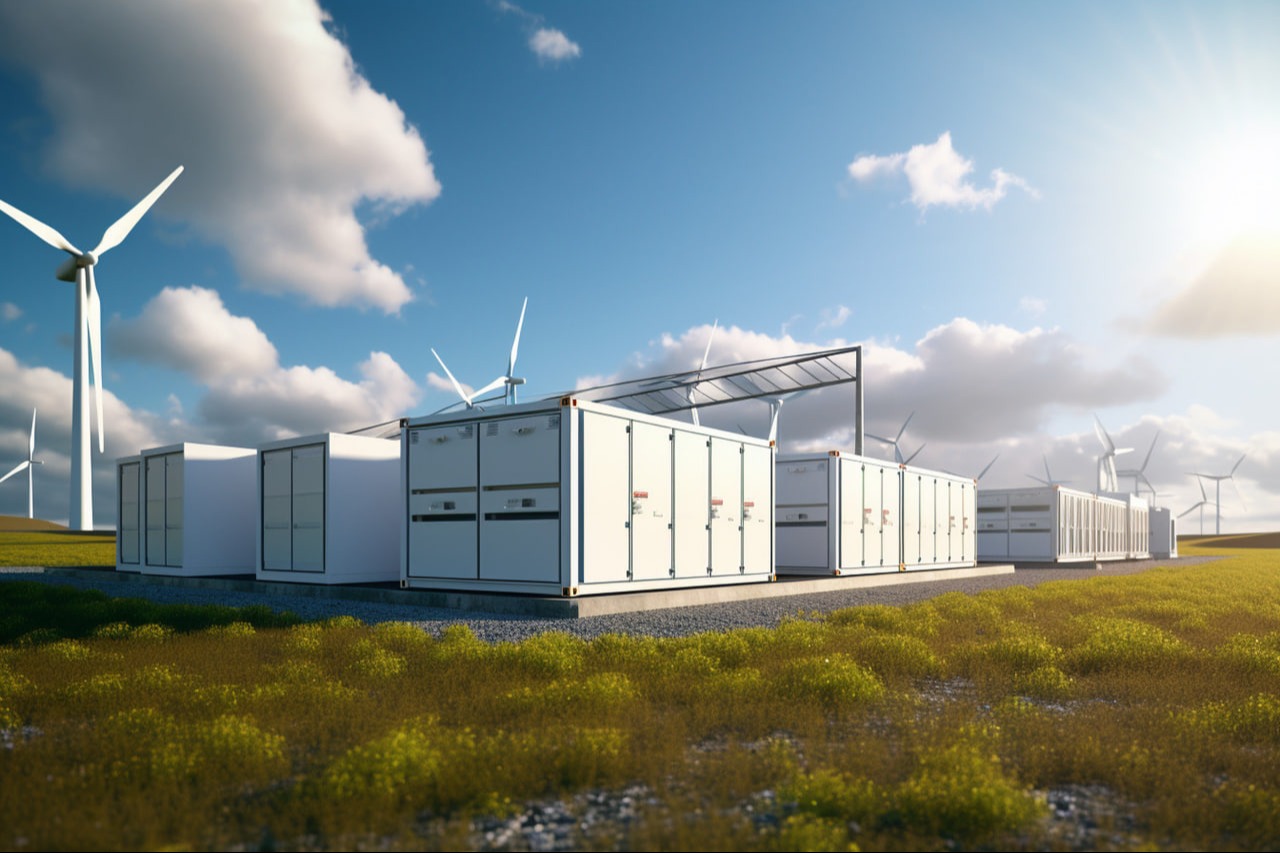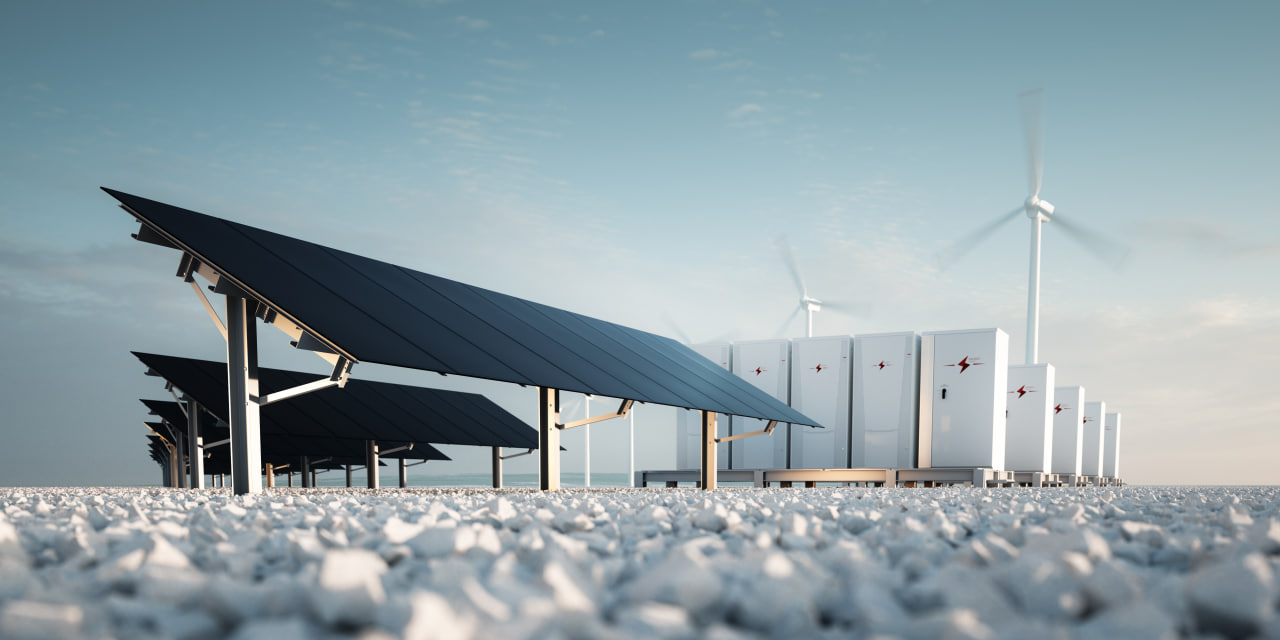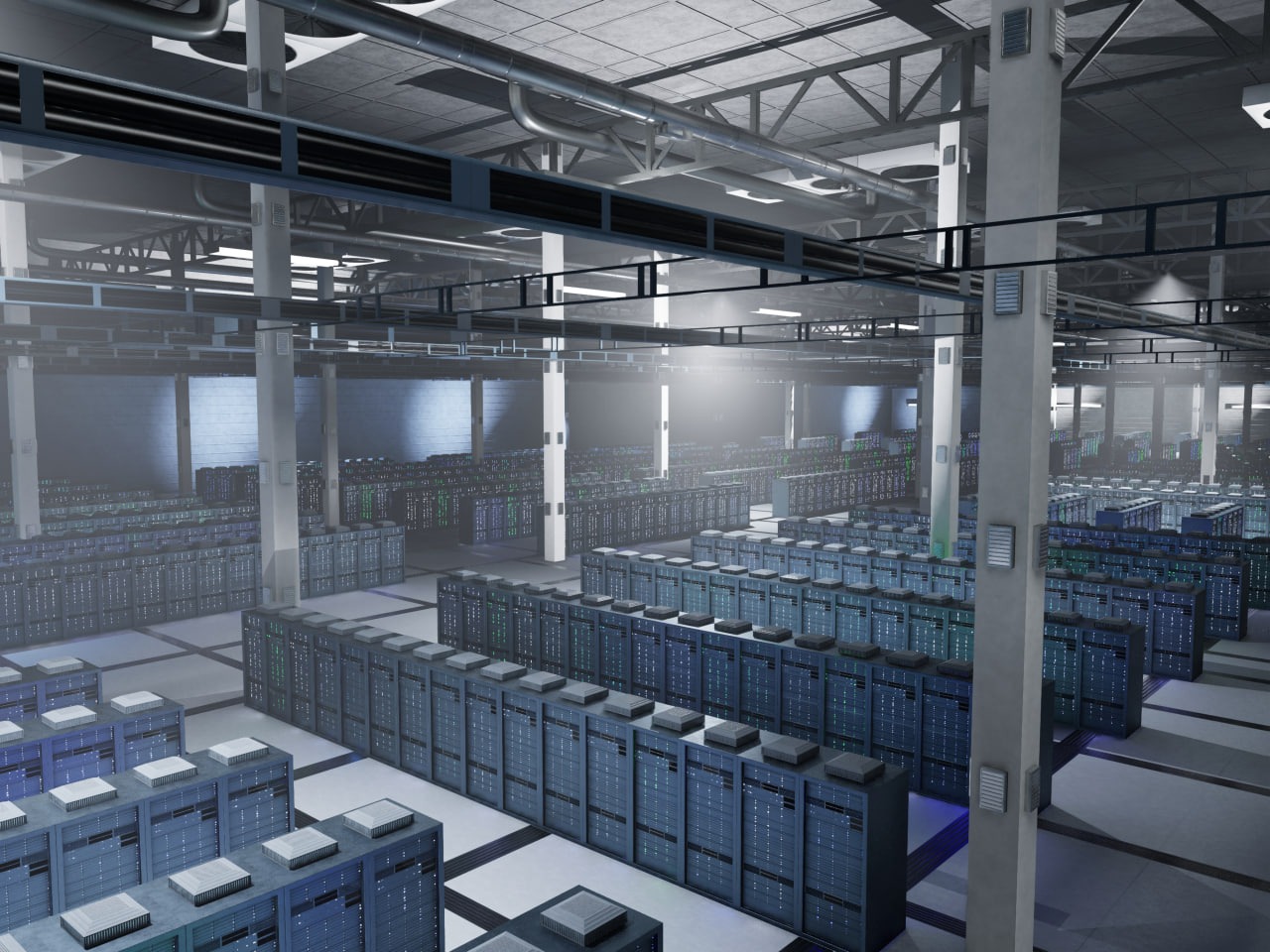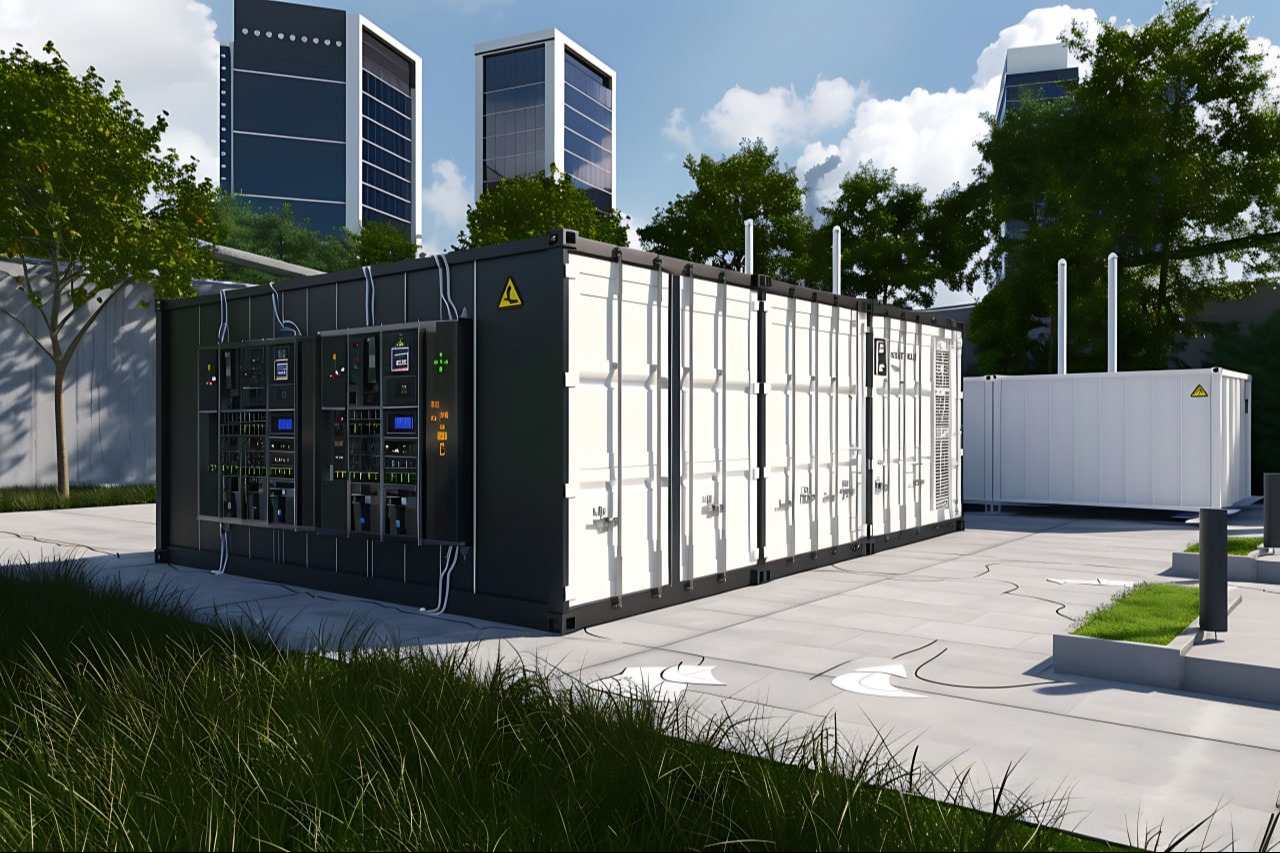
Introduction
Energy storage installations (UZE) or energy storage systems (СНЕ), or Battery Energy Storage System (ВЕСС) are rapidly gaining popularity all over the world - and Ukraine is no exception. This market in our country is already valued at hundreds of millions of euros and continues to grow. And so it's time to figure out what UZE is, how they are arranged, why this market is growing and what problems it faces.
What is ultrasound, how are they arranged, what are they generally used for
Energy storage facilities are a set of equipment for storing, transforming and transmitting electricity. They consist of lithium-ion battery units, energy conversion equipment, auxiliary equipment, engineering structures and communications.
The basic principle of using ВESS is to withdraw energy from the grid when it is generated in excess in order to use it later in a period of shortage. The key characteristics of such installations are power and capacity. The first shows how quickly the system can release energy, and the second shows how much energy it can store.

Prevalence of VESS in Europe
In recent years, the construction of powerful UZEs in the world and in Europe in particular has been rapidly gaining momentum. And even global brands that are not associated with energy are currently actively involved in the development of solutions for VESS. A clear example can be the Mercedes-Benz concern, which uses batteries not only for its electric cars, but also offers solutions for industrial facilities and large UZE.
In general, European statistics are as follows:
-
In 2024 in Europe installed21.9 GWh of new BESS; their total fleet reached 61.1 GWh of energy capacity.
-
The total capacity of all UZEs in Europe last yea rreached35 GW. For comparison, the total capacity of European gas power plants reaches 53 GW. That is, electrochemical "storage" of energy still lags behind traditional hydro accumulators in terms of capacity, but they are quickly catching up and are already comparable.
-
However, gas power plants currently have a much larger capacity than UZE, so there is no question of abandoning them yet. Rather, these energy conservation systems will complement each other. After all, the big advantage of BESS is a much faster response. A gas power plant takes minutes to start up, an ultrasound takes milliseconds. This allows them to provide frequency regulation services - the most complex auxiliary service in the power system.
-
At the same time, experts are evaluated the European need for BESS capacity by 2030 of 200 GW.
-
Meanwhile is expected and capacity growth - up to 400 GWh as early as 2029.
-
The largest USES in Europe: RWE Neurath + Hamm BESS (Germany, 220 MW, 235 MWh), SSE Ferrybridge BESS (Great Britain, 150 MW, 300 MWh), Minety BESS (Great Britain, 150 MW, 266 MWh), Lovech BESS (Bulgaria, 124 MW, 496 MWh).
With the ten largest BESS in Europecan be found in the material on the IKNET website.

What about this market in Ukraine
Ukraine is still lagging behind the general European trend, but is actively catching up, recently UZE has also been dynamically developed in our country. To understand the current situation in our market, it is necessary to consider that it is divided into three segments:
-
UZE as a separate object is a large project aimed at the Transmission System Operator ("Ukrenergo") and distribution system operators. They provide auxiliary services to maintain the frequency (RPCH or аРВЧс) and stability of the entire energy system (BR) and/or trade electricity on the day-ahead market (DAN);
-
BESS for industrial consumers - installed at enterprises to ensure autonomy and economy. They charge when electricity is cheap and give it for their own use or sell it to the network as an "active consumer" when the market price is at its maximum.
-
UZE as part of renewable energy facilities (RES) are integrated with solar or wind power plants to store excess or cheap energy and sell it during peak hours.
1.UZE as a separate object
-
In mid-August 2024, Ukrenergo held a special auction, offering long-term (5-year) contracts for energy storage systems for the first time. This event kicked off the construction of 99 MW of new BESSs in Ukraine, which will be used to provide Frequency Support Reserve (FSR) in the Ancillary Services (FSR) market.
-
During 2024-2025, "Ukrenergo" alsoconductedfew special auctions at the RDP for the purchase of automatic frequency restoration reserves (aRVCH) for a period of 5 years for a total of 1,000 MW. Of which 421 MW are aRVChs, a symmetrical reserve that is able to be unloaded and loaded, depending on the needs of the power system. These needs should also be provided by UZE.
-
In this way, in total, Ukrenergo secured a guaranteed market of 520 MW for UZE through auctions. Moreover, contracts denominated in euros reduce risks for investors and stimulate market development.
-
OKKO company, the first, as early as February 2025, the first put into operation BESS with a capacity of more than 20 MW to provide ancillary services.
-
The largest volume of power – 200 MW (with a capacity of 400 MWh) – was provided by hybrid BESS systems, which started working this fall They are able to maintain the stability of the network (frequency regulation, balancing) and to work on RDN, that is, to feed more than 600,000 households for two hours. The projects were implemented by DTEK in partnership with the company Fluence (Siemens/AES), which is a manufacturer and integrator of BESS.
-
KNESS Company, launched projects with a total capacity of about 100 MW of UZE, which will comprehensively provide services with both RPCH and aRVCs.
As of October 2025, the RPC for the next 5 years is fully loaded. Projects with a total capacity of more than 500 MW are also at the stage of implementation, which will work on the market of Ancillary services and RDN.
2.BESS for industrial users
This segment of the market is on the threshold of a great era, and facilities of hundreds of megawatts are already starting to operate. With a payback of 2-3 years, such installations provide business with reliability, autonomy and economy. At the same time, thanks to cheap loans for appropriate equipment, literally every enterprise can create its own "energy island".
Moreover, in addition to savings, such UZEs at industrial facilities provide an opportunity to provide electricity during peak hours at a high price. This opportunity has expanded significantly since July revision of price caps by the NERCP regulator: increase in the maximum permissible price for electricity in the evening peak hours. This ensured a significant difference between cheap and expensive energy and, accordingly, a larger margin when trading it.
3.UZE as part of RES facilities
The only segment of the market that is still "sliding" at the moment. The main reason: for the owners of already existing SPPs and WPPs operating under the "green tariff" (ZT), the installation of UZE is financially unprofitable. Since the TZ guarantees the state's purchase of all produced energy at a fixed price, regardless of the time period or season.
At the same time, in new solar and wind farms that are being built today, taking into account market mechanisms, BESS is immediately installed as a mandatory component. Also, 2025 was the year of installation of the first UZEs at existing SPPs.
So we can hope that the situation will change in the coming years, and this segment of the market will also become more active.

The market is growing rapidly: the reasons for the relevance of USE in our realities
Actually, the reasons for the relevance of BESS in Ukraine can be divided into two subgroups: those that coincide with the global ones, and those that are specific to our country. The first include:
-
The increase in electricity consumption - from electric cars to data centers and AI, which require more and more power, which must be somehow compensated.
-
The trend towards environmental friendliness and, accordingly, the growth of the share of renewable energy. In particular, solar and wind are unstable, and batteries help balance the system during periods of low and high generation.
-
Cost optimization for business - enterprises with their own UZE can buy electricity at a low rate (for example, at night) and use it when the rate is maximum (evening hours).
-
Reducing the cost of technologies. In the last 2 years alone, prices for electricity storage equipment have more than halved:
-
the cost of 1 MW*h in 2023 - 230,000 euros;
-
the cost of 1 MW*h in 2024 - 160,000 euros;
-
the cost of 1 MW*h in 2025 - 110,000 euros.
Such a drop turned UZE into an economically profitable and competitive solution on the energy market.
-
Resilience of power systems – BESSs help survive various risks such as accidents and disasters.
In the case of Ukraine, the last point expands and becomes almost the main one, since our energy system has been under special threat for the fourth year from the constant shelling of the Russian invaders. The enemy destroyed a large part of the maneuvering facilities, which mainly worked on coal and gas. Also, in our case, a decrease due to the occupation of own production of fossil fuels, on which the energy system is largely oriented, has a significant impact.
In addition to the above, UZEs allow you to earn on the markets of auxiliary services (frequency support) and on the price difference (buying cheap, selling expensive electricity).

Regulatory, investment and other problems and solutions
In Ukraine, the development of the USE market has largely lagged behind the global market due to regulatory and, accordingly, investment troubles. We can say that until 2022, the BESS market in Ukraine actually did not exist. USEs were not clearly defined in the legislation, and accordingly, they could not be integrated into the power system. This created a number of problems, including:
-
Legal uncertainty. Companies did not understand how to license energy storage activities, how to connect to grids, and how to sell the electricity they stored.
-
Lack of incentives for investors. No one wanted to invest in a technology that did not have a clear legal status. Investors need guarantees that their investments will pay off.
How problems were solved:
-
In 2022 was approved special law No. 5436-d, which introduced the concept of "energy storage installation" and storage activity on the electricity market.
-
In July 2022, the market regulator NCREKP confirmed Licensing conditions for carrying out economic activities on energy storage.
-
In 2023-2025, a number of changes were made to the Transmission System Code (TSC) and the Distribution System Code (DSC) - the fundamental documents that regulate the energy market and which now include USE as one of its components.
-
More flexible rules for the use of BESS connected to generating plants, was implemented by Law No. 9381 in January 2025.
-
In July 2025, the NCREKP approved a number of important changes for the implementation of the mechanisms provided for by this law. This removes key barriers to connecting and monetizing USE.

The general trend towards renewable energy and the place of VESS in this context
In recent years, even decades, the civilized world has been on the path of decarbonization – reducing CO₂ emissions and moving away from fossil fuels. Environmentalism is in fashion, green technologies are popular. Including in energy. Solar and wind power generation is being actively developed, instead, stations that operate on fossil fuels - coal, gas, fuel oil - are being closed.
However, such a transition is impossible without the parallel development of UZE. After all, it is "dirty" power plants that belong to the peak maneuvering capacities that are switched on at times of sharp growth in consumption. Of course, neither wind farm nor SES can be used in this way by themselves.
These problems are solved by BESSs, which can store energy during favorable conditions and release it during unfavorable ones. Can be instantly turned on to balance the power system.
One of the trends that indicates the rapid growth and scaling of the BESS market in the world is the standardization of ultrasound solutions from different manufacturers. If a few years ago, manufacturers offered completely different solutions, such as different container sizes, weight, cooling methods, types of battery cells, now they are mostly standardized: a 20-foot container, weighing 42 tons, with a capacity of 5 MWh with a liquid cooling system.
The development of UZE technologies can be compared with the development of panels for solar stations: if 10 years ago the power of a photomodule was 300 W, now it is the same size - 650 W. If now the standard for UZE is a 20-foot container with a capacity of 5 MWh, then in the perspective of the next few years, the capacity of the container may reach 8 MWh.
It is obvious that this market will continue to develop actively in the coming years. After all, more and more investors want to join it - both to save their own funds and to earn money. Despite the current "slippage" of the UZE direction as part of RES facilities, its activation is a matter of time.
At IKNET, we are ready to expand all market segments, and we are already offering comprehensive services for design, selection of equipment and integration of UZE. We are ready to accompany the client throughout the entire cycle of project implementation - from market analysis and financial models to commissioning of installations. With further monitoring of UZE operation, dispatching and full service for maximum savings and profit.
Apply, don't delay, because now is the best time to enter the BESS market!
22.10.2025







